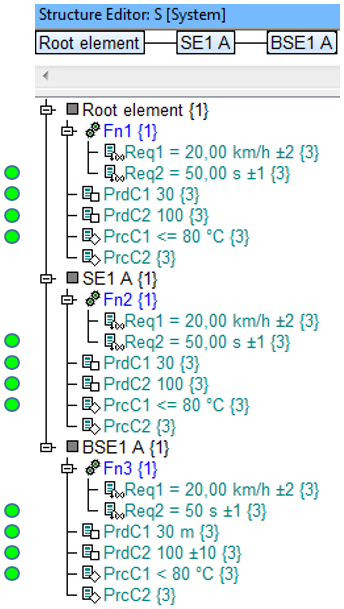Search:
Characteristic- and requirement types with inconsistent specifications
Explanation:
A search will be performed for characteristic- and requirement types (product characteristics, process characteristics, and requirements) with more than instance, whereby the instances have inconsistent specification values
Note:
- Types are IQ-objects that are recorded in Catalogs and carry information that is the same for all instances of the type
- Instances of IQ-objects are created when IQ-objects are selected from the Catalogs and reused elsewhere in the IQ-Software
Example:
Abbreviations
- ASIL = Automotive safety integrity level
- BF = Base failure of a base function
- BFn = Base function of a base structure element
- BSE = Base structure element
- Cl Prc = Classification for process characteristic
- Cl Prd = Classification for product characteristic
- Cl Req = Classification for requirement
- CM = Control method
- DA = Detection action
- DC = Diagnostic coverage
- DSCF = Dangerous safety critical failure
- Er Det = Error detection
- Er Resp = Error response
- F = Failure
- FIT = Failure in time
- Fn = Function
- FSM = Functional safety management
- IE = Inspection equipment
- LF = Latent fault
- LFM = Latent fault metric
- OC = Operating condition
- PA = Preventive action
- PE = Process element
- PFH = Probability of failure per Hour
- PMHF = Probabilistic metric for random hardware failures
- PrcC = Process characteristic
- PrdC = Product characteristic
- QM = Quality method
- QR = Quality rule
- Req = Requirement
- RMR = Risk Matrix Ranking
- RP = Reaction plan
- SE = Structure element
- SE ErDet = Structure element for error detections
- SE ErResp = Structure element for error responses
- SFF = Safe failure fraction
- SG = Safety Goal
- SIL = Safety integrity level
- SM = Organisational-SE for “safety mechanisms”
- SPF = Single point fault
- SPFM = Single point fault metric
- TF = Top failure of a top function
- TFn = Top function at root element
- TS = Test sample

- The above structure consists of three structure elements, each of which have two requirements (
 ), two product characteristics (
), two product characteristics ( ) and two process characteristics (
) and two process characteristics ( ) assigned.
) assigned. - This Quality Rule identifies any characteristic and requirement, that firstly has more than one instance, whereby these instances have different specification values.
- With the correct display options active, namely “Instance count” and “Specification of characteristics”, it is possible to see how many instances ({3}) to each element there are as well as their specifications.
- All instances of PrcC2 have no specification values because these IQ-objects were not assigned any specifications.
Search result: ![]()
This example delivers 12 hits: the instances of Req2, PrdC1, Prd2 and PrcC1.
The instances of PrcC2 are not considered as they do not have specifications assigned.
It is important to note that the specification must be exactly the same in number and spelling for it to be considered the same. Req2 is a good example to show how small difference here also lead to a hit for this Quality Rule: 50,00 s | 50 s.


